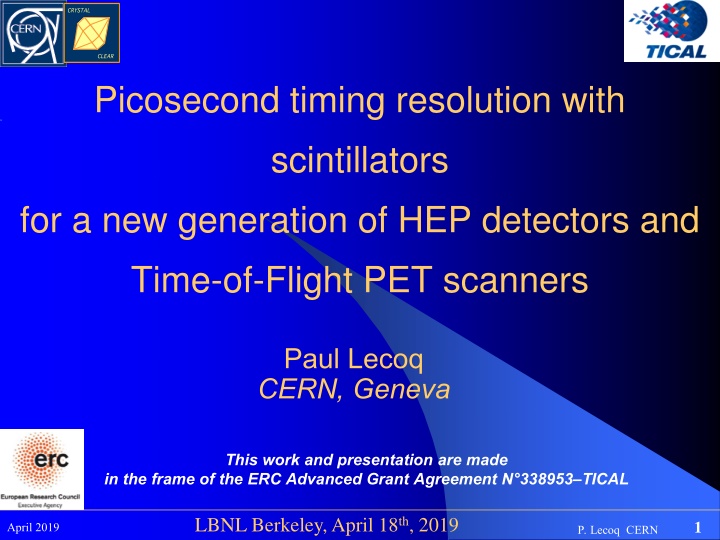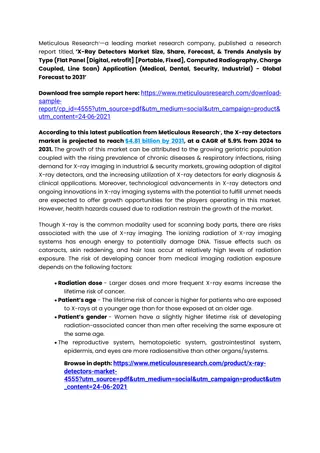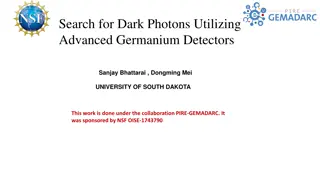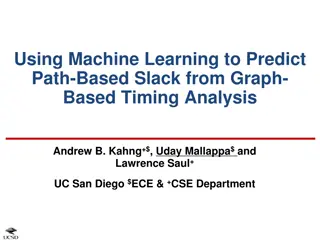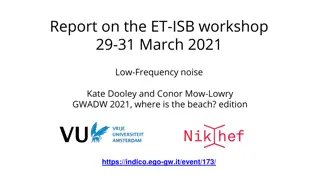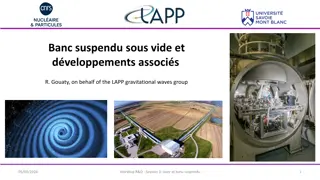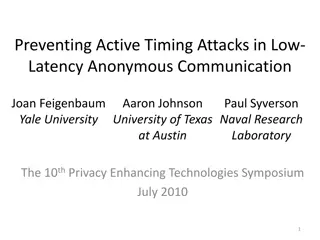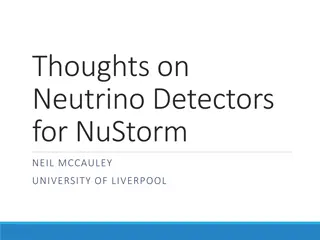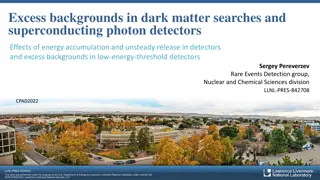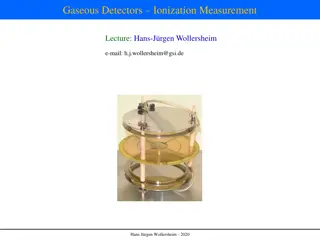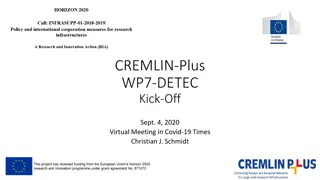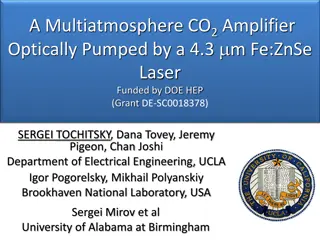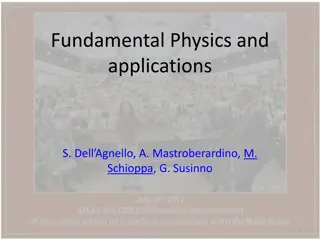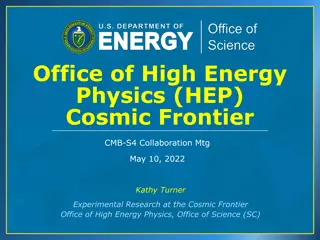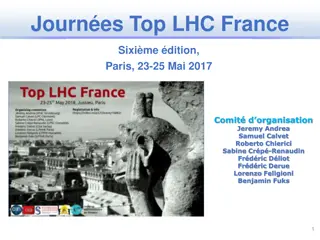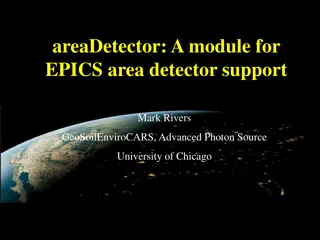Advancing Picosecond Timing Resolution for HEP Detectors
Investigate the advancement of picosecond timing resolution using scintillators for next-gen HEP detectors and TOF-PET scanners. The work presented under the ERC Advanced Grant explores the significance of fast timing in detecting ionizing radiation, mitigating pile-up issues, and enhancing energy resolution at high luminosity colliders. Techniques like Time-of-Flight play a pivotal role in improving sensitivity in various imaging applications, including CT X-Ray, dynamic studies, and more.
Download Presentation

Please find below an Image/Link to download the presentation.
The content on the website is provided AS IS for your information and personal use only. It may not be sold, licensed, or shared on other websites without obtaining consent from the author.If you encounter any issues during the download, it is possible that the publisher has removed the file from their server.
You are allowed to download the files provided on this website for personal or commercial use, subject to the condition that they are used lawfully. All files are the property of their respective owners.
The content on the website is provided AS IS for your information and personal use only. It may not be sold, licensed, or shared on other websites without obtaining consent from the author.
E N D
Presentation Transcript
Picosecond timing resolution with scintillators for a new generation of HEP detectors and Time-of-Flight PET scanners Paul Lecoq CERN, Geneva This work and presentation are made in the frame of the ERC Advanced Grant Agreement N 338953 TICAL LBNL Berkeley, April 18th, 2019 1 April 2019 P. Lecoq CERN
Why fast timing? 1/5 sec 1/500 sec 1/5000 sec LBNL Berkeley, April 18th, 2019 2 P. Lecoq CERN April 2019
Why 10ps timing resolution Time-of-Flight techniques to alleviate the pile-up problem and help improving energy resolution at high luminosity colliders Improve resolution of finely segmented homogenous calorimeters Time-of-Flight PET sanners with > 10 fold improvement in sensitivity CT X-Ray imaging Imaging in turbid media hyperspectral time resolved spectroscopy for high precision dynamic studies of fast phenomena LBNL Berkeley, April 18th, 2019 3 P. Lecoq CERN April 2019
Detection of ionizing radiation What matters? TOF When Particle ID Where Energy Finely segmented calorimeters LBNL Berkeley, April 18th, 2019 4 P. Lecoq CERN April 2019
HEP Principle of pile-up mitigation Use the tracker to determine the z position of the vertex (large angle tracks) Use TOF to associate a time to a vertex For a luminous region distributed over ~ 10cm, collisions will be distributed over ~ 300ps LBNL Berkeley, April 18th, 2019 5 P. Lecoq CERN April 2019
HEP: CMS timing layer 248 832 LYSO/SiPM The CMS Collaboration, Technical Proposal for a Mip Timing Detector in the CMS Experiment Phase 2 Upgrade, CERN-LHCC-2017-027 ; LHCC-P-009 LBNL Berkeley, April 18th, 2019 6 P. Lecoq CERN April 2019
CMS timing layer: beam tests with mip s 3 MeV 5 MeV 3 MeV 30 ps Smaller SiPM / crystal area coverage A.Benaglia, M. Lucchini et al., NIM 830 (2016) 30 LBNL Berkeley, April 18th, 2019 7 P. Lecoq CERN April 2019
Hadron energy deposition in a segmented hadron calotimeter Global time t Local time t-z/c 50GeV proton in a 1x1x3m3 iron block segmented in 1mm thick layers About 1 MeV/mip/layer A. Benaglia, E. Auffray, P. Lecoq, H. Wenzel, A. Para, IEEE Trans. Nucl. Sc. VOL. 13, NO. 9, Sept. 2014 LBNL Berkeley, April 18th, 2019 8 P. Lecoq CERN April 2019
Dual Gate (scintillation) vs Dual Readout (Scint. + Cher.) A. Benaglia, E. Auffray, P. Lecoq, H. Wenzel, A. Para, IEEE Trans. Nucl. Sc. VOL. 13, NO. 9, Sept. 2014 LBNL Berkeley, April 18th, 2019 9 P. Lecoq CERN April 2019
Time of Flight PET t = tA tB = [(d+d1) (d-d1)]/c d1 = c t/2 10ps TOF resolution Detector B tB d d1 Patient e+ SNRTOF/SNRCONV= 16! d dx = 1.5mm e- tA SNRTOF = (2D/cDt) SNRconv Detector A d dt (ps) d dx (cm) SNR* 16 10 0.1 100 300 500 5 5.2 1.5 3.0 4.5 2.3 State-of-the-art 7.5 * SNR gain for 40 cm phantom LBNL Berkeley, April 18th, 2019 10 P. Lecoq CERN April 2019
Why 10ps TOFPET? TOF for direct 3D information Requires 10ps TOF resolution for 1.5mm resolution along LOR Allows limited angle tomography without artifacts > 15-fold improvement in S/N ratio, even more with high random rate Equivalent potential in dose reduction (0.5mSv/scan) Annual natural background: 2.4mSv Return flight Paris SFO: 0.11mSv Allows longer longitudinal studies per injection Reduce the cost of radiotracer production infrastructures Less sensitive to incorrect attenuation correction and normalization Less stringent requirements on CT: cost, dose reduction Reduce problems of not direct attenuation measurement in PET/MR Open PET to new categories of patients (children, f tus) Conventional PET 10ps TOFPET LBNL Berkeley, April 18th, 2019 11 P. Lecoq CERN April 2019
Where are we today for PET? Measured with FBK NUV-HD (25 m SPAD size, 4x4mm2 device size) 2x2mm2 crystal cross section, T=15 C NINO 30% 98ps 44% 58ps Breaking news HF electronics S. Gundacker et al, 2016 JINST 11 P08008 LBNL Berkeley, April 18th, 2019 12 P. Lecoq CERN April 2019
The detection chain Crystal SiPM electronics How to extract the best time estimator t from the signal? t + tSPTR tkth pe= + tk ph + ttransit + tTDC Transit time jitter TDC Scintillation process Single photon time spread Conversion depth conversion time Unwanted pulses 1 DCR, cross talk Afterpulses Random deletion 1 Absorption Self-absorption Random deletion 2 SiPM PDE Unwanted pulses 2 DCR LBNL Berkeley, April 18th, 2019 13 P. Lecoq CERN April 2019
Classification of scintillators Ideal Scintilllator LBNL Berkeley, April 18th, 2019 14 P. Lecoq CERN April 2019
Prompt photons to boost the timing resolution Cramer Rao calculations including photon transfer time spread (PTS) and light transfer efficiency (LTE) of a 2x2x3mm3 LYSO:Ce ,Ca crystal, glue-coupled to a 4mm2 FBK-NUV HD SiPMs with 40um SPAD size S. Gundacker, CERN LBNL Berkeley, April 18th, 2019 15 P. Lecoq CERN April 2019
Possible sources of prompt photons ( < 1ns) Ce3+ Activator: 5d-4f Ca2+ & Mg2+ co- doping r ~ 20 ps d ~ 16 ns Excitons/Bi-exciton stable at 300 K Hot Intraband Luminescence 0.1 - 10 ps High donor band semiconductors <1ns quenched at room temperature Cross Luminescence <1ns <300 nm low LY Cerenkov ~ 5-10 ps LBNL Berkeley, April 18th, 2019 16 P. Lecoq CERN April 2019
LSO:Ce,Ca / BaF2 Courtesy of Hamamatsu Eg 1400ph/MeV 600ps 220nm h Crossluminescence 50 50 Air coupling: LTE = 35% Glue coupling: LTE = 68% S. Gundacker, CERN LBNL Berkeley, April 18th, 2019 17 P. Lecoq CERN April 2019
Hot intraband luminescence The small energy relaxation rate below the ionization threshold leads to: a high density of optical and acoustic phonons local heating, shock wave, transient absorption a dynamic e population change from the top to the bottom of the conduction band If the density of states is not uniform in the conduction band a competition can take place between phonon mediated non- radiative relaxation and radiative relaxation between conduction sub-bands LBNL Berkeley, April 18th, 2019 18 P. Lecoq CERN April 2019
Hot intraband luminescence Ultrafast emission 10-12s e-IBL: broad spectrum in visible range H-IBL: NIR psectrum Independant of temperature Independant of defects Absolute Quantum Yield Wh /Wphonon= 10-8/(10-11-10-12) 10-3to 10-4 ph/eh pair Higher yield if structures or dips in CB? Interesting to look at CeF3 Omelkov et.al., J. Lum., 176 (2016) 309 317 LBNL Berkeley, April 18th, 2019 19 P. Lecoq CERN April 2019
Search for Candidates for Hot intraband luminescence Search for materials with splitting of the conduction/valence band Search for materials with flat sub-bands for a perfect delocalization of the electrons/holes Examples Oxy-halide compounds Ba4OF6 4.61g/cm3 GdOF 7.51g/cm3 LBNL Berkeley, April 18th, 2019 20 P. Lecoq CERN April 2019
Cerenkov contribution LuAG:Ce LuAG:Pr 3,4 Cerenkov photons 0,28% LuAG:Pr, Ca S. Gundacker, E. Auffray, K. Pauwels, and P. Lecoq, Phys. Med. Biol. , vol. 61, pp. 2802 2837, 2016. LBNL Berkeley, April 18th, 2019 21 P. Lecoq CERN April 2019
Lowering Cerenkov threshold ? Cerenkov threshold (101keV in LSO) can be strongly lowered ( 100 s eV) in specifically designed nanostructured metamaterials Related more formally to the Smith Purcell effect A kind of Cerenkov or transition radiation emission free electron lasers Produce constructive interference of resonance transition radiation (plasmonic states) in photonic crystals ? ? 1 ? ???? !! No velocity threshold !! ? = Y. Yang et al., Nature Phys. Lett., 16 July 2018 I. Kaminer et al., Nature Comm., 13 June 2016 LBNL Berkeley, April 18th, 2019 22 P. Lecoq CERN April 2019
Lowering Cerenkov threshold with hyperbolic metamaterials Isofrequency contour from dispersion formula: k = Isofrequency contour from dispersion formula: k = 2? ?~ ? 2? ?~ ? ?~ ? ? ? for isotropic dielectric material for anisotropic hyperbolic material ?? + ??2 ??2 ??2 ??~ ?2 ?? + ??2 ??2 ?? + ??2 ?? - ??~ ?2 Infinite density of photonic states in dw Finite density of photonic states in dw k+ kz kz k+ Fast e- kx kx Slow e- k- k- M. Silverinha, Nature Photonics, Vol. 11, May 2017 LBNL Berkeley, April 18th, 2019 23 P. Lecoq CERN April 2019
Multi-exciton quantum confinement XX XXX X xx= 4 x xxx= 9 x x CdSe/ZnS txxx= 69ps tx~ 1ns txx= 196ps Padilha et.al., Nano Lett. 2013, 925-932 LBNL Berkeley, April 18th, 2019 24 P. Lecoq CERN April 2019
GOS in 1D quantum confined systems J.Grim, I. Moreels ITT, Italy LYSO plate 200mm thick + CdSe/CdS nanoplate film 20mm thick 372 nm laser or X-rays 20mm CdSe film deposition Streak Camera LYSO 200mm Focal spot optical table 530nm 530nm 420nm R. Martinez Turtos et al., JINST_068P_06 LBNL Berkeley, April 18th, 2019 25 P. Lecoq CERN April 2019
Limits of bulk materials Performance Limitation Courtesy of G. Bizzari, Cranfield University LBNL Berkeley, April 18th, 2019 26 P. Lecoq CERN April 2019
Towards heterostructures Performance Optimisation Courtesy of G. Bizzari, Cranfield University LBNL Berkeley, April 18th, 2019 27 P. Lecoq CERN April 2019
Metamaterials From the Greek meta-, metamaterials means beyond materials (i.e. natural materials) Prompt emission Quantum confined (bi)-excitons in nanocrystals High stoping power L(Y,G)SO, (La,Ce)Br3, BGO, CsI Light transport to SiPM Photonic crystals, photonic fibers LBNL Berkeley, April 18th, 2019 28 P. Lecoq CERN April 2019
Metapixels under study Evaluation of the photodetection efficiency in a sampling geometry with 2 active materials Evaluation of the energy leakage from the dense to the fast material CTR estimation from a full MC simulation of prompt and scintillation photons LBNL Berkeley, April 18th, 2019 29 P. Lecoq CERN April 2019
CdSe/LYSO plates Metapixel Fit on Rise & decay Time w/o peak 200mm thick LYSO plates + 20mm effective thickness CdSe/CdS nanoplatelet film 3x3x3mm3 LSO trise = 70ps S. Gundacker, R. Martinez-Turtos, CERN LBNL Berkeley, April 18th, 2019 30 P. Lecoq CERN April 2019
CdSe/BGO plates Metapixel 200mm thick Naked BGO plates 2x2x3mm3 200mm thick BGO plates + 20mm thick CdSe/CdS nanoplatelet film 2x2x3mm3 S. Gundacker, R. Martinez-Turtos, CERN LBNL Berkeley, April 18th, 2019 31 P. Lecoq CERN April 2019
Energy sharing studies BGO block 2x2x3mm3 NUV-HD SiPM 40mm SPAD (FBK) CTR with 57ps LSO pixel LYSO block 2x2x3mm3 NUV-HD SiPM 40mm SPAD (FBK) 121ps BGO DTR=107ps BC418&BC422 block 2x2x3mm3 NUV-HD SiPM 40mm SPAD (FBK) LYSO DTR=54ps BC422 DTR=25ps LBNL Berkeley, April 18th, 2019 32 P. Lecoq CERN April 2019
BC422/BGO plates Metapixel 200mm thick BGO plates 125keV 300keV + 200mm tBC422 2x2x3mm3 CTR with 57ps LSO pixel CTR with 57ps LSO pixel CTR with 57ps LSO pixel CTR with 57ps LSO pixel 110ps 70ps 87ps 87ps S. Gundacker, R. Martinez-Turtos, CERN LBNL Berkeley, April 18th, 2019 33 P. Lecoq CERN April 2019
Considerations for heterostructures design Keep the density/photofraction close to the scintillator host (BGO, LSO) Reach a reasonable balance between the standard/prompt photon light yield Transport efficiently the light from both components So far, simple and non optimised proof-of-concept designs UCLA CdZnS/CdS BGO comb 200m mm ZrO2plates 100m mm holes, 300m mm spacing 3D printing CERN LBNL Berkeley, April 18th, 2019 34 P. Lecoq CERN April 2019
Particularities of energy sharing in heterostructures Timing resolution is different for all events For a given fraction F of events sharing their energy, the number of events benefiting from a CTR improvement is: F(2-F) > F 2/3 events share energy in 100mmBGO/100mmBC422 89% events will have a CTR better than bulk BGO CTR is much less dependant on detection threshold LBNL Berkeley, April 18th, 2019 35 P. Lecoq CERN April 2019
Conclusion- Potential of metamaterials By making use of light-management strategies, Nanophotonics privides a playground to make the unimaginable come closer. This opens the way to transformation optics (a kind of extrapolation of Maxwell s equations invariance under Lorenz transformation), allowing to envision a distortion of real space that results in a desired functionality: Ultrafast emission Enhanced fluorescence yield through plasmonic resonances Redirect light into preferred directions Electromagnetic cloaks Improve thermal dissipation In our case, this is a fertile field for developing innovative solutions for ultrafast Light production Light transport Light photoconversion LBNL Berkeley, April 18th, 2019 36 P. Lecoq CERN April 2019
The best metapixel requires the best SiPM LBNL Berkeley, April 18th, 2019 37 P. Lecoq CERN April 2019
New SiPM concept The Quantum Silicon Detector LBNL Berkeley, April 18th, 2019 38 P. Lecoq CERN April 2019
The 10ps challenge: a spur on the development of fast timing an opportunity to get together an incentive to raise funding a way to shed light on nuclear instrumentation for medical imaging One unique challenge launched for 5 to 10 years and operated by an international organisation with rules issued by the community based on the measurement of CTR combined to sensitivity Several milestones and prices: 3 years after the launch of the challenge: 1M expected for the Flash Gordon prices for the realisation of 3 important milestones until the end of the challenge: 1M expected for the Leonard McCoy price for the first team meeting successfully the specifications of the challenge LBNL Berkeley, April 18th, 2019 39 P. Lecoq CERN April 2019
Conclusion New, intelligent Multifunctional sensors Disruptive technologies Nano-photonics New perspectives Impossible is not a French word Napol on LBNL Berkeley, April 18th, 2019 40 P. Lecoq CERN April 2019
Many thanks to LBNL Berkeley, April 18th, 2019 41 P. Lecoq CERN April 2019
